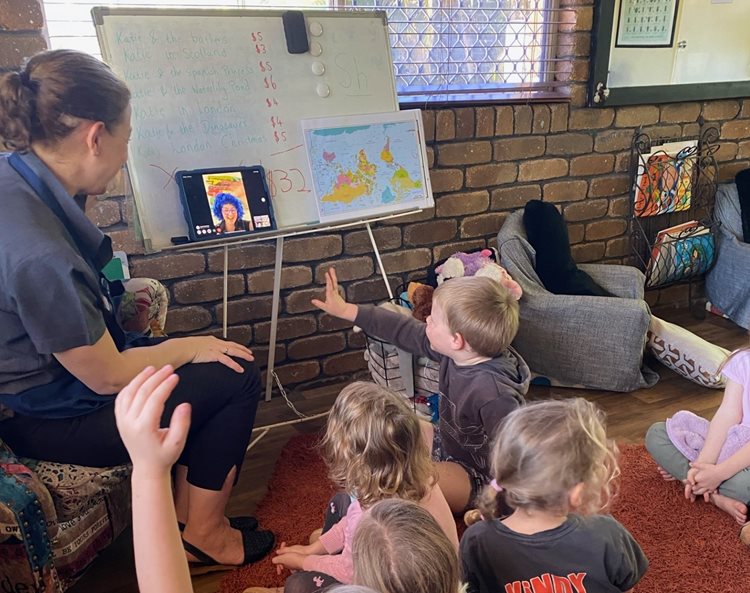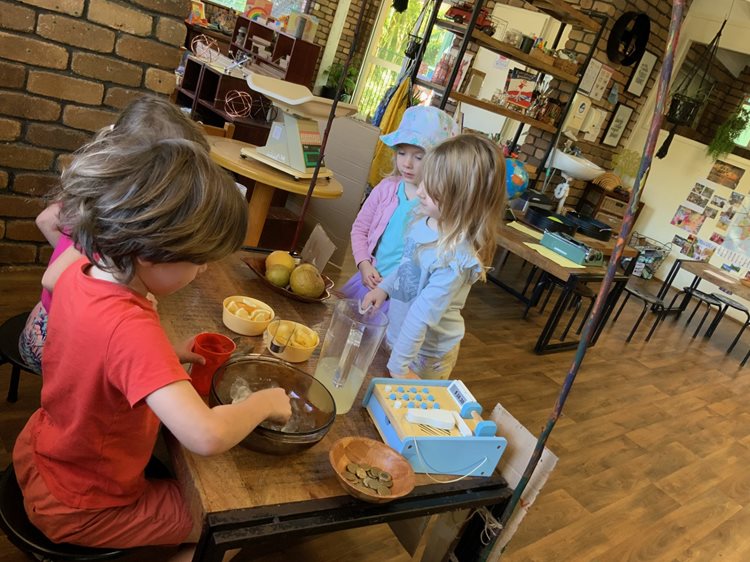“We were reading the book 'Katie and the Starry Night' by James Meyhew the Friday before last," recalls Jackie. "The children enjoyed the book so much that when we got to the back page showing all the other books in the series, they asked whether we could buy them all.”
A conversation around how money could be earnt ensued, with Jackie giving children the agency to brainstorm ideas together with her support.
It wasn’t long before a child drew a connection to another story, "What should Danny do?" by Adir and Ganit Levy, where Danny sets up a lemonade stand. Inspired, the children proposed a similar idea to raise funds for the full set of "Katie" books.
Jackie wrote all the ideas down, but reminded the children that they were already busy with a Conceptual PlayWorld experience focused on the "Carla’s Adventures" books by Missy Tarantino, that had so far taken them to India, Guatemala, the Northern Territory and New Zealand, so the initiative may need to be put on hold for a while (read more about Conceptual PlayWorlds later in the article).
However, the children’s enthusiasm for the task was not to be postponed, and during the ensuing weekend, one child had already organised lemons to make lemonade and others had started to visualise how the stand might look. The fundraiser for the books was happening, whether Jackie was ready or not, so she swiftly jumped on board.
“During the week, the children meticulously planned every detail, from engaging me to help them find the ideal recipe, to engineering the stand from objects found during our bush walk,” recalls Jackie. “They even used gems and pirate coins to work out how much money they would need to charge for the lemonade to earn what they needed to buy the books.
“Roles were thoughtfully assigned for each child including a chief managing officer, design experts, sign writers, and more. Despite all the work required, they made it all happen very capably, with just a bit of support from educators.”
But the fun didn't stop there. Weaving in elements from a previous Conceptual PlayWorld journey based on "The Smeds and The Smoos" by Julia Donaldson, it was decided that the books would be purchased from Grandma Smoo’s bookshop. After a Zoom call to speak with Grandma Smoo, it was agreed that she would hand deliver the books once the money had been raised.

The children speak with "Grandma Smoo" about the fundraiser
Last Friday, exactly a week after the idea for the project arose, a successful lemonade stand fundraiser was held. The children raised exactly the right amount of money to buy the books and Grandma Smoo will visit later this week to deliver the books.

What is a Conceptual PlayWorld?
Monash PlayLab has introduced a novel approach to teaching STEM to young children through play, known as a Conceptual PlayWorld. This method is rooted in research conducted by Laureate Professor Marilyn Fleer and her team.
Conceptual PlayWorlds always begin with a story. Both adults and children immerse themselves in an imaginary world where they collaboratively address challenges and learn STEM concepts. This model is Australia's first research-based approach to teaching STEM.
Five stages of creating a PlayWorld:
- Selecting the story: The story should have a complex plot, multiple characters, and drama, and should be enjoyable for the educator. It should be engaging for both the children and the educator. Examples of starter PlayWorlds include "Rosie’s Walk", "There’s a Hippopotamus on Our Roof Eating Cake", and "The Very Hungry Caterpillar".
- Designing spaces: Educators should think creatively about using spaces, both inside and outside. For instance, an obstacle course could lead to a special tree or chair, or a block corner could transform into a PlayWorld.
- Entering and exiting the PlayWorld: This involves determining how one enters and exits the PlayWorld. It could be through a magic wand, costume, tunnel, chair, or door frame. The idea is to enter and exit as a group.
- Plan your problem to be solved: Introduce a problem or challenge within the PlayWorld that needs to be addressed. For example, in the PlayWorld with the lemonade stand, the children have to work out how to raise the money to purchase more books.
- Role of the teacher: Educators can take on various roles within the PlayWorld, either as an equal play partner with the children or in a leading role guiding them through the process.
Watch Laureate Professor Marilyn Fleer describe PlayWorlds and the five stages:
The benefits of PlayWorlds
Jackie says that experiences like the lemonade stand have brought to bear the multifaceted benefits of PlayWorlds in her service including:
STEM learning: Beyond the fun, children grapple with complex concepts, from budgeting to strategic planning, in a hands-on, tangible manner.
Social skills: Collaboration, communication, and teamwork are at the heart of every PlayWorld.
Emotional development: Children develop empathy, understanding, and emotional intelligence, immersing themselves in diverse characters and scenarios.
Inclusivity: "Whether a child is shy, has speech challenges, or is new to the English language, the universal language of imagination ensures they're included,” shares Jackie “Taking on a character often gives children the courage to step out of their comfort zones, fostering confidence and self-expression."
Behaviour: The immersive nature of PlayWorlds often leads to a reduction in challenging behaviours. Children are so engrossed in their roles and the storyline that, in Jackie’s experience, disruptions become rare.
How to get started
Conceptual PlayWorlds are designed to assist early childhood educators in leveraging the power of play to impart STEM knowledge to young children. This teaching model is grounded in contemporary research and has been co-developed with educators referred to as STEM champions or ambassadors (Jackie is one of them). The platform offers free online professional development and a variety of PlayWorld scenarios adaptable for different educational settings.
As I reflect on the lemonade stand initiative, I'm reminded of the wonders of learning through play,” says Jackie. “It's a journey of discovery, exploration, and joy. And as educators, there's no greater reward than witnessing the magic unfold right before our eyes.
You can register for the free PlayWorlds professional development here: https://www.monash.edu/conceptual-playworld/educators/professional-development